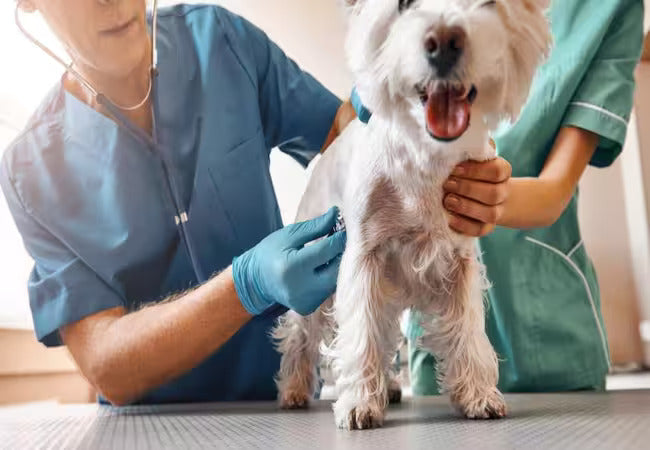Urine Crystals in Dogs: Veterinary Guide & Care Tips 2025 🩺🐾

In this article
Urine Crystals in Dogs: Veterinary Guide & Care Tips 2025 🩺🐾
By Dr. Duncan Houston BVSc
Hello, I’m Dr Duncan Houston BVSc, veterinarian and founder of Ask A Vet. In this 2025 edition, we’re tackling the common yet often misunderstood issue of urine crystals (crystalluria) in dogs. Whether these crystals are benign or a red flag, this comprehensive guide will help you recognize types, understand causes, guide diagnostics, and implement prevention and care strategies—boosted by support from Ask A Vet. Let’s dive in! 💙🐶
1. What Are Urine Crystals? 🤔
Urine crystals are tiny mineral deposits seen under a microscope during urinalysis. They form when urine becomes supersaturated with compounds like struvite, calcium oxalate, cystine, urate, silica, or xanthine. While small numbers can be normal, abundant or specific types may hint at urinary or systemic disease.
2. Common Crystals & What They Mean 🧪
- Struvite (magnesium ammonium phosphate): Often associated with urinary tract infections or alkaline urine; may form stones.
- Calcium Oxalate: Linked to acidic urine, high dietary calcium or ethylene glycol ingestion; may lead to stones.
- Urate: Common in Dalmatians or those with liver shunts; acidic urine contributes.
- Cystine: Rarest; genetic reabsorption defect, especially in male dogs; can form stones.
- Silica & Xanthine: Linked to certain diets or metabolic disorders; less frequent.
3. Causes & Risk Factors ⚠️
- High urine pH (alkaline or acidic) and mineral overload—dietary composition plays a key role.
- Concentrated urine due to low water intake.
- UTIs—especially with urease-producing bacteria that raise pH and foster struvite 🚿.
- Systemic diseases: liver shunts → urates, endocrine disorders → calcium balance issues.
- Breed and genetic predisposition—certain breeds are more prone to specific crystals.
4. Signs That May Accompany Crystals 🕵️♂️
Crystalluria itself is often silent. Look for:
- Blood in urine (hematuria)
- Straining or frequent urination, dysuria
- Urinary accidents or leakage
- Discomfort, abdominal pain
- Obstruction signs (in males due to small urethra): lethargy, vomiting, inability to urinate—urgent!
5. How Veterinarians Diagnose the Issue 🔬
- Urinalysis & microscopic exam: crystal type, quantity, pH assessment; bacterial culture as needed.
- Blood tests: check kidney health, calcium, liver enzymes, endocrine markers.
- Imaging: Radiographs or ultrasound to detect stones or obstructions.
- Stone analysis: post-removal, reveals composition to guide prevention.
6. Treatment & Management 🛠️
6.1 Address Underlying Causes
- UTIs: Culture-directed antibiotics to resolve infection and stop crystal formation.
- Diet changes: Prescription urinary diets tailored to crystal type (acidify for struvite, alkalinize for oxalate, low purine for urates).
- Hydration: Encourage fresh water, wet food, fountains to dilute urine.
6.2 Remove Stones or Obstructions
- Small stone passage: Urohydropropulsion may flush stones.
- Lithotripsy (ESWL) or laser therapy for fragmentation.
- Surgical cystotomy for larger stones.
- Urethral catheterization or stents if obstruction present.
6.3 Ongoing Monitoring & Prevention
- Recheck urinalysis & imaging every 3–6 months.
- Maintain tailored diet and hydration routine.
- Supplement use (e.g., potassium citrate) in recurrent calcium oxalate.
- Monitor pH at home with urine strips.
7. Role of Ask A Vet💡
- Ask A Vet: Telehealth consults, urinalysis interpretation, UTI guidance, follow-up reminders.
8. When to Contact the Vet 🚨
- Straining without passing urine, blood in urine
- Frequent accidents, pain during urination
- Obstruction signs: lethargy, vomiting, altered mental state, emergency care needed
9. Living with Crystal-Prone Dogs 🏡
- Keep water fresh and accessible—add water to food, use fountains.
- Maintain consistent feeding with specialized diet only.
- Routine vet checks and season-long monitoring.
- Educate household: early sign recognition, avoiding high-mineral treats.
10. Final Thoughts 📝
Urine crystals are not always cause for concern, but they can point to infection, stones, or metabolic conditions. With targeted diagnosis, appropriate diet and hydration, timely interventions, and regular monitoring—supported by Ask A Vet your dog can lead a healthy, crystal-free life. Stay informed, proactive, and connected. 🐾💙
If your dog shows urinary symptoms—or you're managing recurrent crystalluria—schedule a telehealth consult via AskAVet.com and download our app for ongoing guidance and reminders. 🌟






